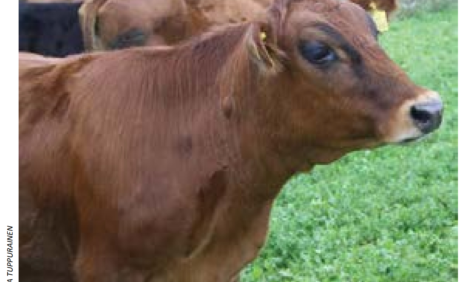



Reproduction Success in the Cow Herd
By by Lori Weddle-Schott, Regional Extension Educator. Minnesota University Extenxion, Beef Centre. As cattlemen focus on the current calving season, they should not lose sight of the next most critical management issue-the upcoming breeding season. A successful breeding season will in turn result in both greater reproductive efficiency and higher profits for producers. When cows are not managed to rebreed quickly, the profitability of the beef operation is negatively impacted. Cattlemen should pay particular attention to a critical period of time after a cow calves called “anestrus”. Anestrus is the period of time right after a cow gives birth, when her reproductive abilities are on hold until her body can build up enough energy reserves to allow her to become receptive to rebreeding. Nursing calves and poor nutrition are major causes of anestrus. Beef producers who monitor anestrus, herd nutrition, body condition and address herd health issues should achieve optimum reproductive efficiency. Let’s look at a few of the key elements that ensure reproductive success.
Nutrition: Nutrition is a critical factor that effects reproduction. Successful reproduction is based on the same necessary nutrients as those needed for maintenance, growth and lactation. These nutrients include energy, protein, vitamins and minerals. Nutrient deficiencies or excesses can lead to reduced reproductive performance. Research has shown that for each 10% of body weight lost before calving can result in a delay of the first heat period by 19 additional days. Cows to thin at calving take longer to recover and to start cycling for rebreeding. These cows will have lower conception rates than cows in moderate-to-good condition at calving. It is important to bring thin cows into condition now, to improve the odds of success at the start of the breeding season. Remember that all cows that are offered the same ration after calving will not be able to maintain uniform conditions. Competition at the feed bunk, social rank and efficiency of nutrient use for maintenance and milk production influences a cow’s ability to maintain weight. Even when a high plane of nutrition is being offered after the calving, some cows will lose weight. Timid, young or smaller animals may not have adequate access to the feed buck and will not be able to obtain their full daily ration. Nutrient intake of these cows will be reduced followed by problems with rebreeding. Management tools such as dividing the cow herd into two groups according to nutritional needs and feeding them accordingly will not drastically increase feeding cost and could have significant impact on rebreeding success.
Body Condition Scores: Body Condition Scores (BCS) are used to monitor the nutritional status of the cow herd. Maintaining proper BCS on breeding cattle is directly linked to proper nutrition and is an important reproductive function. The Body Condition Scoring System is based on a “1-to-9” scale, with “1” being extremely thin and “9” being obese. In general we consider “1-to-4” as being thin. Cattle in “5-to-7” are in the normal range and should breed at an optimum level. Finally “8 & 9” BCS are fat and may have problems breeding and maintaining early pregnancy, along with difficulties calving. Thin cows, that are BCS 4 or less, are the ones that need to be managed. These thin cows typically have problems exhibiting estrus and breeding. Focus on providing these cows with a higher quality forage or supplementation to rebreed. A good rule of thumb in utilizing the BCS system is the visual concept that each condition score is equivalent to 60-80 lbs. A fat cow with a BCS of 7 can coast along on a lower quality feed source and even lose weight down to a BCS of 5 without detrimental effects. In comparison to cows with a BCS of 3, that needs to gain on an average 140 lbs. before calving if they are to successfully rebreed. Now is the time for producers to focus on bringing thin cows into condition so it will improve the odds of success during the breeding season. Focus on getting these cows on a better feed program or moved to the best pasture conditions to improve the quality of nutrition.
Herd Health: A good vaccination program, which is developed in cooperation with your veterinarian, is also a key factor in reproductive success. Prior to the start of the breeding season, implement yearly vaccinations against diseases such as Vibro, Lepto, IBR, PI3, BVD and BRSV. At least 30 days before the start of breeding season, have all herd sires pass a Breeding Soundness Exam. Plan ahead so there is time to discuss herd health with your veterinarian and adjust management practices that will improve your herd health program.
Breeding Records: Accurate records of reproductive factors can help you measure your program’s effectiveness. “You can’t manage what you don’t measure” is an important phrase when you evaluate your herd’s reproductive successes. Important traits to evaluate are last year’s pregnancy percentages, calving percentages, percent calf crop weaned and the calving interval on each individual animal. A set of records that focus on these factors are one of several management tools that will allow producers to look at their operation in terms of the net value of beef produced.
A well managed breeding program that focuses on these key factors can greatly improve your reproduction productivity and reduce your cost of production. For more information on breeding management visit the U of M Beef Team website at: www.extension.umn.edu/beef/.
May 2007



